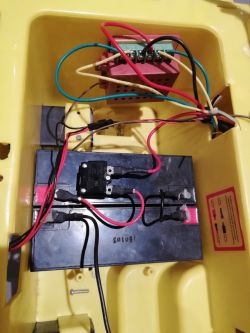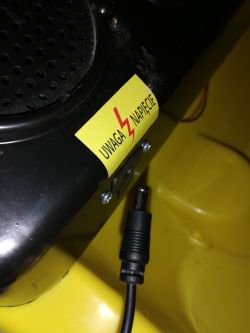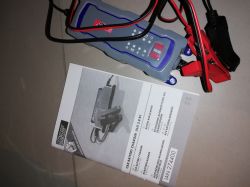FAQ
TL;DR: Missing charger? Use a smart 12V unit; its 0.8 A mode is safe—“Will be OK.” Charge via the series jumper (12V) or each 6V separately using the correct mode. Avoid high‑current modes. For parents fixing 2×6V ride‑on cars when the original charger is missing. [Elektroda, fotomh-s, post #17228275]
Why it matters: This helps you safely charge and diagnose 2×6V gel batteries without damaging the pack or toy car.
Quick Facts
- Two 6V batteries linked by a jumper act as one 12V pack; you can replace them with a single suitable 12V battery. [Elektroda, fotomh-s, post #17228308]
- Ultimate Speed ULG 3.8 B1: use Mode 1 (6V) per battery or Mode 2 “motorcycle” for the 12V pack; it can charge at ~0.8 A. [Elektroda, fotomh-s, post #17228275]
- If a smart charger won’t start, briefly precharge the pack with another 12V source, then reconnect the smart charger. [Elektroda, kierbedz4, post #17229889]
- Deeply discharged gel batteries may be unrecoverable; even a lab supply can fail to revive them. [Elektroda, fotomh-s, post #17229944]
- Some ride‑ons switch 6V/12V via the speed selector; fixed‑jumper harnesses run 12V only. [Elektroda, Anonymous, post #17230341]
How do I charge two 6V batteries in a toy car without the original charger?
Use a smart charger and connect across the series pack. Clip red to the + of one 6V battery and black to the − of the other. Leave the jumper linking the middle terminals; it forms a 12V pack. Set the charger to 12V for this configuration. To charge each battery individually, set the charger to 6V and do them one at a time. If the charger refuses to start, the batteries may be too discharged. [Elektroda, fotomh-s, post #17228254]
Which charger settings work best (modes, current)?
On an Ultimate Speed ULG 3.8 B1, use Mode 1 (6V) for a single 6V battery. Use Mode 2 “motorcycle” for the two batteries in series as a 12V pack. The unit can charge at about 0.8 A, suitable for small gel cells. Avoid Modes 3 and 4 due to higher current. As one expert noted, “Will be OK.” [Elektroda, fotomh-s, post #17228275]
Can I charge the two 6V batteries separately?
Yes. Charge each 6V battery individually with the charger set to 6V. When charging both together via the jumper, set the charger to 12V. If the charger refuses to begin, it may be detecting too low a voltage, which indicates deep discharge. Precharge briefly, then try again. [Elektroda, fotomh-s, post #17228254]
My charger flashes all LEDs and won’t start. What does that mean?
Smart chargers need minimal pack voltage to power their electronics. Deeply discharged batteries fall below that threshold, so the charger blinks and aborts. Briefly lift the pack voltage with another 12V supply or charger, then reconnect the smart charger to begin normal charging and float maintenance. [Elektroda, kierbedz4, post #17228339]
What’s the correct way to connect the clamps on a two‑battery series pack?
Connect red to the positive terminal of one 6V battery and black to the negative terminal of the other 6V battery. Keep the jumper linking the remaining two terminals; it makes a 12V pack. Use 12V charger mode when charging across the series pack. [Elektroda, fotomh-s, post #17228254]
Can I replace 2×6V with one 12V battery?
Yes. A fixed jumper across two 6V batteries already creates a 12V source. You can install one suitable 12V battery instead, ensuring fit and connectors match. Vehicle performance remains 12V‑based with either configuration. [Elektroda, fotomh-s, post #17228308]
Does a two‑speed ride‑on car need two batteries?
It depends on wiring. Some models route batteries through the speed selector to switch between 6V and 12V. Others use a fixed jumper, so the vehicle always runs at 12V. Inspect your harness to confirm which layout you own. [Elektroda, Anonymous, post #17230341]
Will a higher Ah battery make the car run longer?
Yes. Amp‑hours indicate stored charge. At the same load, a higher Ah battery increases runtime roughly proportionally. Confirm the larger battery fits the compartment and remains compatible with your charger’s settings before purchase. [Battery University, 2023]
Can I test the car using a 12V alarm battery?
Yes. You can safely connect a known‑good 12V alarm battery to verify the drivetrain and wiring. This quick test helps confirm a battery issue before buying replacements. [Elektroda, fotomh-s, post #17228320]
How do I tell if a 6V battery is too far gone?
Measure open‑circuit voltage with a multimeter. If it reads clearly below 6.0 V per 6V battery, it is likely unsalvageable. Deep discharge damages gel cells quickly. Try individual charging only if the reading is near 6V. [Elektroda, fotomh-s, post #17228295]
Can a lab power supply revive a deeply discharged gel battery?
Usually no. When gel batteries are deeply discharged, even a laboratory supply may not charge them. Some attempt adding distilled water or voltage tricks, but sulphation often prevents recovery. “Generally, gel battery after deep discharge is useless.” [Elektroda, fotomh-s, post #17229944]
How do I kick‑start a dead pack so the smart charger will engage?
Follow this precharge routine:
- Disconnect the pack from the toy’s wiring.
- Briefly connect another 12V supply or charger to raise pack voltage.
- Reconnect your smart charger; it will charge, then switch to maintenance automatically.
This overcomes low‑voltage lockout in many smart chargers. [Elektroda, kierbedz4, post #17229889]
 .
. 














